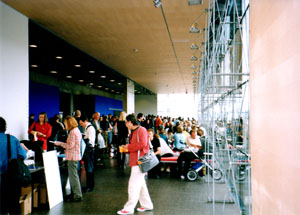 Early Start...We've now started the last day of the conference proper here in Helsinki - with a session on open source cultures that also contains my own paper. I'll blog most of this but of course not my paper itself - I'll upload this to this site soon. Not a bad turnout for a 9.30 start on a Saturday morning, either!
Early Start...We've now started the last day of the conference proper here in Helsinki - with a session on open source cultures that also contains my own paper. I'll blog most of this but of course not my paper itself - I'll upload this to this site soon. Not a bad turnout for a 9.30 start on a Saturday morning, either!
Mark Tribe has now made a start on his panel, beginning with a brief history of free and open source software (FOSS) and its ideology. But Mark's own interest is in open source as a broader cultural phenomenon, which also occurs in the domain of art (and he quotes Stravinsky as saying that "a good composer doesn't imitate, he steals"). This of course is a key development of the last century - the conscious building of new art on existing material, be it ideas or actual found material (as also in the emergence of collage as a new art form - take the dada movement for example).
Mark refers to this as already a kind of open source culture. Of course media culture became an even more important trope in (post)modern art in the second half of the twentieth century. Beyond collages, conceptual, film, video, and performance art also developed a culture of integrating and building on existing materials. The Internet makes it particularly easy to do this, of course - grabbing existing Websites and re-publishing them in revised forms is easily possible, and this has been used in a variety of ways.
The documenta X Website (which was meant only to be up during the exhibition in Kassel itself was copied and republished wholesale by an artist annoyed at this temporal limitation; other artist-built systems allow to nominate Websites and have the re-published in transmogrified versions automatically. Mark also notes hip-hop and other turntabling- and sampling-based forms of music as kinds of open source styles (but is this truly 'open' source if samples now have to be licenced by the artist, or are alternatively stolen or 'plundered' from the original artists?).
Mark now notes the question of legality especially in the face of changing IP law. Recently IP terms have been extended to significant lengths, and are increasingly belligerently defended by the major copyright holders. Even 'fair use' provisions are now coming under significant attack, and the question isn't simply actual enforcement but also the kind of self-censorship that the threat of enforcement engenders. Alternative to this is the idea of the creative commons, of course. Mark suggests that the frontline now lies with the artists and other creators themselves: if they take on the CC idea then no copyright legislation in the world will be able to stop the use if their work.
Miller Puckette is next. He comes from a mathematics background but has been involved also in computer music since the 1980s. For IRCAM he has written a piece of software called Max. He suggests that some see a boundary between tools and content, but does this boundary truly exist? Tools themselves could also be works of art (e.g. a Stradivarius violin). There also is a kind of infectuousness of the medium (or tool?) which is used to make content - the medium affects the possibilities of content (this is a pretty McLuhanite argument, I guess).
Today, of course, the key medium is digital information itself. Back in the 80s, there were two worlds - the academia where sharing software and content was ubiquitous and no commercial value was perceived in it. On the other hand there also was a commercial industry already, of course. Particularly in France where IRCAM was located, software was very highly guarded by its commercial owners. This became more complicated when computer-assisted music composition moved from tape to real-time - music composers would be told that they were free to compose yet their compositions would only run on in-house proprietary software...
Max was later licenced out to various distributors, and is still on the market (but Miller last worked on it in 1989). When IRCAM developed its high-end Interactive Signal Processing Workstation, Max was ported to the system and moved from Midi to direct audio processing. (Max is a programming environment for making real-time electronic art - a tool which enables computers to respond live to user [artist/audience] inputs.) Later, Miller left IRCAM. He moved on from Max (which was still covered by IRCAM's copyrights, of course) to developing a new, this time open-source system called PD.
As a non-commercial piece of software, this was much harder to bring to the attention of a large audience - and yet the development if it was far more rewarding than that of Max. In fact, ultimately the ongoing problems with Max IP meant that PD has now become more widespread than that - open source licences were far easier to apply now.
 My Audience (argh, without flash)On to me... (Powerpoint of the presentation, 92k; Word document, 84k). Whew, that went well. Some very good questions afterwards, and I had the impression that this audience (perhaps more so than others I've delivered similar papers to in the past) just got it. Even at this early hour.
My Audience (argh, without flash)On to me... (Powerpoint of the presentation, 92k; Word document, 84k). Whew, that went well. Some very good questions afterwards, and I had the impression that this audience (perhaps more so than others I've delivered similar papers to in the past) just got it. Even at this early hour.













